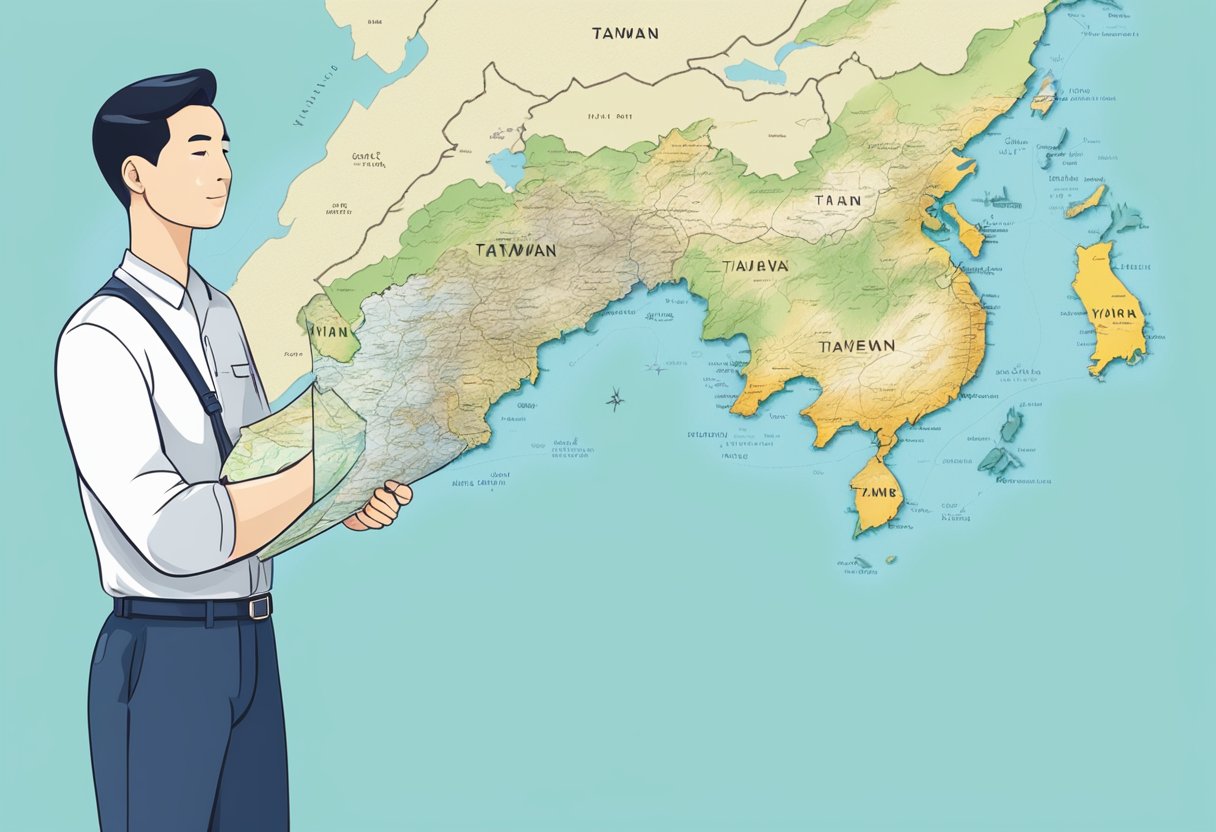Taiwan Pronunciation Guide: Mastering the Correct Sounds
Mastering the correct pronunciation of Taiwan can enhance both communication and cultural understanding. Pronunciation can vary notably between different regions and languages within Taiwan, making it a fascinating subject for linguistic study. The standard pronunciation in English, as agreed upon by most linguistic resources, follows a specific phonetic pattern that can be practiced and learned.

Learning accurate pronunciation is not just about the mechanics of speech but also about appreciating the significance of the island’s unique identity and history. As you navigate through the complexities of Taiwanese and regional languages, you might encounter challenges in pronunciation that require attention to detail and an understanding of local nuances. Embracing these subtleties helps in fostering better interpersonal exchanges and deeper connections with the culture.
Key Takeaways
- Pronouncing Taiwan correctly is essential for effective communication and understanding.
- Taiwanese pronunciation varies across regions, reflecting the island’s linguistic diversity.
- Addressing pronunciation challenges enriches cultural connections and interpersonal interactions.
The Basics of Taiwan Pronunciation
Taiwan’s pronunciation landscape reflects its diverse linguistic heritage, impacting how words are enunciated across different systems and accents.
Phonetic Systems and Taiwan Pronunciation
Taiwanese language employs several phonetic systems to aid pronunciation. Among these, Mandarin Chinese is taught using Hanyu Pinyin, the official Romanization system in Taiwan, facilitating clear pronunciation guidelines. For indigenous Taiwanese languages and dialects, systems like Zhuyin Fuhao, also known as Bopomofo, provide phonetic transcription that differs from Pinyin.
Mandarin Chinese Influence on Pronunciation
Pronunciation in Taiwan is heavily influenced by Mandarin Chinese, the official language. However, the island’s version of Mandarin has subtle differences from the Mainland China variant, owing to historical separations and local linguistic evolution. The standard Mandarin Chinese taught in Taiwan uses Traditional Chinese characters instead of Simplified Chinese.
Differences in English Accents
When Taiwan pronunciation is filtered through English accents – be it UK or US – there are noteworthy variations. The IPA (International Phonetic Alphabet) transcription for the English pronunciation of ‘Taiwan’ mirrors the phonemes commonly found in both accents, providing a standardized guide. Notably, the phonetic symbols for Taiwan, like /taɪˈwɑn/, remain consistent across different English-speaking regions.
In learning and understanding how Taiwan is pronounced, approaching it through examining phonetic systems and recognizing the Mandarin influence with its distinctive traditional character use is integral. Similarly, the awareness of how English accents can alter Taiwanese pronunciation is crucial for English speakers.
Taiwanese and Regional Languages
Taiwan exhibits a rich linguistic tapestry, with the Taiwanese language primarily rooted in Southern Min dialects, while Mandarin serves as the official language. Dialects such as Hokkien and Hakka further enrich the island’s linguistic diversity, reflecting historical and cultural ties with Fujian Province.
Mandarin vs Taiwanese Language Pronunciation
Mandarin, the official language of Taiwan, has a phonetic structure that differs significantly from Taiwanese, which is a variant of Hoklo originating from Southern Min dialects spoken in Fujian Province. Taiwanese Mandarin pronunciation follows standard Mandarin with some local variations, whereas Taiwanese, also known as Hokkien in the linguistic context, possesses distinct sounds and tones that are not found in Mandarin.
Hokkien and Hakka Influence on Taiwan Pronunciation
Hokkien, the prestige dialect of Southern Min found in Taiwan, has had a significant influence on the everyday speech patterns on the island, especially in cities like Tainan and Kaohsiung. Hakka language, another major regional language spoken in Taiwan, spurs from the Hakka people who originated from regions like Fujian and Guangdong in China. Both Hokkien and Hakka pronunciations hold a unique place in Taiwan’s pronunciation landscape, embedded within various regions and communities.
Southern Min Dialects in Taiwan
Southern Min dialects, particularly Hoklo and Taiwanese, are widely spoken throughout Taiwan, with roots tracing back to migration waves from the Fujian Province and Xiamen area. These dialects maintain a complex tone system and distinct articulation that can differ even between neighboring communities, highlighting the rich linguistic diversity within Taiwan itself.
Pronunciation Challenges and Tips
This section offers insights into the frequent pitfalls learners face while trying to pronounce English in Taiwan, alongside strategies and tools to aid in overcoming these obstacles.
Common Pronunciation Mistakes
Taiwanese students often encounter specific English sounds that do not exist in the Taiwanese language, leading to common pronunciation mistakes. For example, differentiating between the letters ‘l’ and ‘r’, or pronouncing ‘th’ which can result in “feel” sounding like “fear” or “feew.” Learners may also struggle with vowels that alter meaning with slight changes in pronunciation, such as the difference between “ship” and “sheep.”
Resources for Learning Taiwanese Pronunciation
There are various resources available for students to improve their English pronunciation. Websites like VoiceTube provide daily pronunciation challenges and feedback from experienced teachers. YouTube also serves as a significant resource where learners can find numerous channels dedicated to language learning, offering practices on phrases and vocabulary tailored to Taiwanese speakers.
Techniques for Mastering Taiwan Pronunciation
Students learning English in Taiwan can benefit from techniques that focus on the nuances of phonetic sounds. It’s crucial to consistently practice speaking out loud and listen attentively to native speakers. Recording one’s own voice and comparing it with correct pronunciations can highlight areas for improvement. Engaging in language exchange with native English speakers provides real-world practice and immediate feedback, accelerating the learning process.
Cultural Context and Pronunciation
The cultural milieu of Taiwan has shaped its unique pronunciation patterns over time, including influences from political leaders to interactions with neighboring regions.
Influence of Political Figures on Language
In Taiwan, political figures have played a pivotal role in influencing language use and pronunciation. Leaders like Tsai Ing-wen, Ma Ying-jeou, and earlier Chen Shui-bian have not only guided the political landscape but also impacted linguistic preferences, leading to variations influenced by political ideologies and policies. Public speeches and political discourse often showcase these variations, reflecting subtle shifts in pronunciation that resonate with their respective political and cultural agendas.
Taiwanese Pronunciation in Greater China and Southeast Asia
The ripple effects of Taiwanese pronunciation extend across the Taiwan Strait and into Greater China as well as Southeast Asia, including regions like Hong Kong, Malaysia, and Singapore. The Taiwanese diaspora and media influence have led to the spread and sometimes adoption of Taiwanese pronunciation nuances. This is often seen in the entertainment industry, where Taiwanese media is consumed and vocabularies borrowed, creating a blended linguistic landscape across these Chinese-speaking communities.
Historical Changes in Taiwan Pronunciation
Taiwan’s phonetic landscape has undergone changes from the era of Taihoku under Japanese rule to contemporary Tainan dialects. These shifts are marked by historical events and the ever-evolving cultural tapestry of the island. The amalgamation of indigenous languages, the influence of Japanese colonization, and the reintroduction of Mandarin after World War II have all contributed to the distinctive phonological traits of Taiwanese Mandarin, distinguishing it from the Standard Mandarin used in Mainland China.
Technological Impact on Taiwan Pronunciation
Advancements in technology have significantly influenced the way Taiwan pronunciation is taught and practiced, with a range of digital tools available to assist in learning Mandarin Chinese, Hoklo, and other Taiwanese languages.
Software and Applications for Pronunciation Training
Technology has revolutionized the pronunciation training for languages spoken in Taiwan, including Mandarin Chinese and the region’s native Hokkien. Innovative programs, such as MyET, leverage advanced audio and visual technology to help learners improve their speech production. These applications often incorporate phonetic systems to guide users in achieving accurate pronunciation, making use of voice recognition and feedback mechanisms to correct and refine learners’ spoken language skills.
For example, software developed in Taiwan often includes modules specifically for Mandarin Chinese and Hoklo, paying special attention to the nuances of Taiwanese phonetics. By employing such tools, learners not only work on their accent but also improve their understanding of the tonal nature of these languages.
Online Platforms and Digital Media
The Taiwanese language has also found a new avenue of dissemination and education through online platforms and digital media. YouTube, in particular, has become a prolific source of pronunciation guides and instructional videos. These cater to a wide audience, ranging from beginner to advanced levels, and often include interactive elements that encourage viewers to practice speaking.
Online resources have made it easier than ever for students to access pronunciation training anytime and anywhere. This convenience has enabled learners to engage more deeply with Taiwanese languages, facilitating regular practice that is necessary for mastering pronunciation. Notably, users can find an array of free and paid pronunciation guides specifically tailored for various dialects spoken in Taiwan, such as Hokkien (Hoklo) and Hakka.
Frequently Asked Questions

This section addresses common inquiries about the pronunciation of Taiwanese names, words, and the correct application of phonetic rules in English.
What is the correct way to pronounce the capital city of Taiwan, Taipei?
The capital city of Taiwan, Taipei, should be pronounced as “TIE-pay.” The emphasis is placed on the first syllable with a high flat tone.
How is the Taiwanese Mandarin greeting ‘hello’ properly articulated?
In Taiwanese Mandarin, the greeting ‘hello’ is articulated as “nǐ hǎo,” pronounced “nee how.” It’s essential to use the correct tonal inflections: the second tone for “nǐ” (rising tone), and the third tone for “hǎo” (falling-rising tone).
Could you explain the correct pronunciation of the letter ‘T’ in English?
The letter ‘T’ in English is typically pronounced as a voiceless alveolar stop. The tongue should touch the alveolar ridge behind the upper front teeth, and then the air is stopped briefly before being released.
What phonetic rules apply to the pronunciation of foreign proper nouns in English?
When pronouncing foreign proper nouns in English, it’s important to respect the original language’s phonetic rules when possible. This includes acknowledging stress patterns, tonality, and specific sounds that may not be native to English.
Can you provide guidance on the nuances of pronunciation for Asian country names?
With Asian country names, pronunciation should try to mirror the native articulation. For example, “Korea” is pronounced as “ko-REE-uh,” emphasizing the second syllable, and “Japan” is articulated as “juh-PAN,” with stress on the second syllable.
What are some common challenges English speakers may face when pronouncing Taiwanese names and words?
English speakers may face challenges with the tonal nature of Taiwanese names and words, as English is not a tonal language. The differentiation of sounds that are not present in English, such as the distinction between aspirated and unaspirated consonants, can also pose difficulties.

